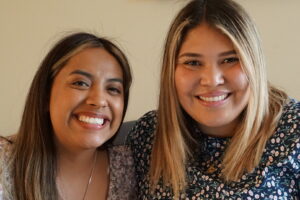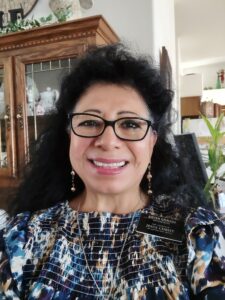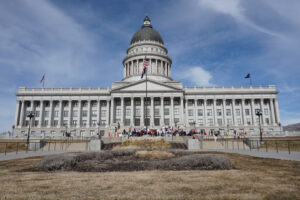A warm, golden haze settles over the apartment as the sun begins to set over the jagged mountaintops of Provo.
Karla Lopez and Ale Angulo, two first generation Americans currently pursuing bachelor’s degrees, work on their never-ending stream of homework. Angulo, an immigrant from Costa Rica, aspires to become a lawyer. Lopez, an immigrant from Mexico, is pursuing a career in public health. They work hard, knowing that to be an immigrant in America is to be constantly proving to the world that they deserve to be here.
Economic hardship in their native Costa Rica brought Angulo and her family to the United States. Her roommate, Lopez, came to the United States from Mexico with her family at the age of nine for similar reasons. Lopez and Angulo are now both in the BYU Pathways program and working towards receiving their degrees, but their lives have not been without struggle.
“We had to become adults at a very young age because our parents relied on us to read immigration documents. We had to know how to sign ourselves up for school. Because of this, I’m pretty aware of things that are happening in the world,” said Angulo.
Neither Lopez nor Angulo were able to receive Deferred Action for Childhood Arrivals (DACA) due to the year in which they arrived in the United States. They learn, work, drive and date in the United States and have for most of their lives, yet both remain without citizenship. The bureaucratic red tape and government backlogs have not been in their favor.
“You can go to school but it’s still hard because you can’t apply for FAFSA because they need a Social Security number and all these things that I don’t have. Sometimes it’s frustrating because you want to do so much but you can’t. But my parents would always say, ‘It doesn’t matter what your status is, you can still fly,’” said Lopez.

Karla Lopez and Ale Angulo are two first generation Americans. (Marissa Lundeen)
Stories like these are the fabric of America. The United States is an ethnic tapestry, a country built by and for immigrants. From the early 15th century to today, immigrants have populated America and made the great experiment a reality.
In his 1989 farewell address, President Ronald Reagan said the following: “I’ve spoken of the shining city all my political life, but I don’t know if I ever quite communicated what I saw when I said it. But in my mind it was a tall, proud city built on rocks stronger than oceans, wind-swept, God-blessed and teeming with people of all kinds living in harmony and peace; a city with free ports that hummed with commerce and creativity.
“And if there had to be city walls, the walls had doors and the doors were open to anyone with the will and the heart to get here. That’s how I saw it, and see it still. And she’s still a beacon, still a magnet for all who must have freedom, for all the pilgrims from all the lost places who are hurtling through the darkness, toward home.”
“And she’s still a beacon, still a magnet for all who must have freedom, for all the pilgrims from all the lost places who are hurtling through the darkness, toward home.” – Ronald Reagan
Reagan’s vision is a beautiful one; a vision of an America that has open doors, open hearts and open minds. This vision becomes less of a dream and more of a reality as immigration misinformation is dispelled by reputable, verifiable research and the sharing of immigrants lived experiences.
The doors open to Dinorah Graham
Growing up the oldest of nine children in Guatemala, the idea of coming to the United States never crossed Dinorah Graham’s mind. It was a dream she didn’t know she could dare to dream. While serving a mission for The Church of Jesus Christ of Latter-day Saints, Graham met a friend who encouraged her to come to the United States and study English. After receiving her student visa, Graham was able to enter the United States where she met and later married her husband.
Over time, Graham was able to receive citizenship and she and her husband raised their family in Arizona. Now the director of the Mesa Welcome Center, Graham has the opportunity to welcome and support those who are entering this country, just as she did years ago.

Passport photo of Dinorah Graham, an immigrant from Guatemala, who was the first in her family to come to America. (Photo courtesy of Dinorah Graham)
“Every immigrant has a different story, a different experience. Everyone. It’s like two women being pregnant. Both are pregnant but both are having a unique experience. No one statement can speak for two immigrants,” said Graham.

Current photo of Dinorah Graham, a first generation American. (Photo Courtesy of Dinah Graham)
America has welcomed millions of immigrants since its founding, fueling the country’s population and economic growth. According to the Pew Research Center, foreign-born Americans and their descendants have been the driving force behind U.S. population growth since the 1965 law that rewrote national immigration policy. Between 1965 and 2015, the US population grew by 131 million, with 72 million of those people being either immigrants or the children of immigrants.
One in 72 million
When Rose Rojo’s mother, Josefina Morales, came to the United States from Mexico, 15 years old and pregnant, she was less concerned about her future and more concerned about the future of the young life she carried inside her. After joining her family in California, Morales soon became the provider for not only her own children but also her siblings when her mother suddenly passed away.
Morales received her citizenship seven years ago and is currently the manager of a nutraceuticals company. Although she has obtained her papers, not everyone in her life has been so fortunate, with much of her family and even her husband still awaiting their citizenship. Rojo and her mother have witnessed firsthand the benefits of citizenship and the barriers to getting there.
“If you see people doing good in your country, why not give them a chance?” said Rojo. “I want the Mexicans and Hispanics to use their voices. I want them to know they have a voice. Mexicans can make a difference too. We can be smart, we can gain an education; we are people too. That’s what makes us united in the first place, is that everyone in this country is coming from different places.”

Rose Rojo with her mother, Josefina Morales, on the day of Rojo’s wedding. (Photo courtesy of Rose Rojo)
“That’s what makes us united in the first place, is that everyone in this country is coming from different places.” – Rose Rojo
Immigrants’ contribution to the work force, propensity for innovation and spending power also makes them vital to the economy. As of 2020, the majority of workers considered “essential” by the Department of Homeland Security’s standards were immigrants, with 19.8 million foreign-born essential workers. Immigrants account for 1-in-5 of all workers dispersed among U.S. food supply chains. Immigrants not only fill blue collar jobs, but they also contribute to America’s thriving entrepreneurial spirit.
As of 2020, 44% of Fortune 500 companies were founded by either immigrants or the children of immigrants. For many leaving their native lands and entering the United States, they pack not only their cultural traditions and heritage but also their dreams. As a result, roughly 3.2 million immigrants operate their own businesses within the United States.
Erika Seastrand’s entrepreneurial mother
Erika Seastrand grew up hearing fragments of her mother’s immigration story. However, as immigration has come to the forefront of American politics in the past five years, her mother has gradually shared her experience. When Erika’s Japanese mother, Takako Seastrand, married an American man, they decided to move their family to the United States.
Her mother, unfamiliar with English and American customs, felt ostracized and alone. According to Erika, one of the most difficult parts of being the child of an immigrant was seeing people treat her mother as if she wasn’t intelligent simply because her native language wasn’t English. Takako Seastrand now owns and operates her own small business and speaks English well, but Erika says her mother’s early hardships as an immigrant still cast a shadow over her life today.
“I still think my mom is facing the repercussions of some of the trauma she went through from when she first moved here and didn’t have the words to defend herself or stand up for herself,” said Erika. “We live in a country that is known as a melting pot. We have so many opportunities for exposure to diversity. Just because someone is different in your community doesn’t mean you have to become totally like them.
“You can celebrate your differences without taking away from who you are, or who they are. Only good can come from it. I’d like to think that my mixed heritage is some sign or representation of the fact that we can beautifully blend things together,” said Erika.
“I’d like to think that my mixed heritage is some sign or representation of the fact that we can beautifully blend things together.” – Erika Seastrand
The work ethic and innovation of immigrants contributes to the American economy in a myriad of ways, and a significant one is the spending power immigrants wield and the taxes they contribute. Immigrants, documented and undocumented, pay billions of dollars in taxes each year. For those undocumented immigrants paying taxes, they are contributing to a system they cannot benefit from.
Immigration is more than an issue to be debated and used as leverage in political campaigns. Karla, Ale, and the millions of others like them have helped shape America into the land of the free and the home of the brave. However, since almost the inception of the United States of America to present day, anti-immigration misinformation and sentiment has poisoned the rhetoric surrounding the flow of immigration to the US.
Anti-immigration rhetoric is nothing new. From the Know Nothings of the 17th century to the John Tanton’s of the 21st, opponents of immigration have long blamed immigrants for the degradation of the United States. However, data and research do not support this claim, and in fact show that immigration is integral to America’s success.
If data indicates that immigration is both beneficial and necessary to the United States, why it is that the plight of immigrants is often used as a scapegoat for the nation’s problems? Charles Kuck, an immigration attorney and managing partner of the immigration law firm Kuck Baxter in Georgia, says the answer is simple: fear.
“The modern rhetoric really stems from fear,” says Kuck. “I recognize that fear because it is something endemic to people who don’t like new things. During the rise of the first real generation of immigrants, from about 1820 to about 1850, the population of America quintupled. We went from 5 to 25 million people in 30 years. We had never seen anything like it. And that’s when you saw in the late 40s and early 50s of the 19th centuries the rise of the anti-immigration parties,” said Kuck.
“The Know Nothings were the party of stopping immigration to America. These people grew up with people that looked like them, and then 20 years later they look up and people don’t look like them anymore. People don’t talk like them anymore. People don’t act like them anymore. And this makes them angry, and it makes them afraid,” said Kuck.
Losing faith in the American dream
Astrid’s Melendez’s mother was 14 years old when she crossed the border with only $40 in her pocket. She spent three hours hiding in a dry riverbed when border control nearly captured her group, but eventually made it safely to the United States. Melendez’s father, from El Salvador, was granted asylum in the United States after being conscripted to fight in his home country’s civil war.
The Melendez’s have built a life for their family in the United States, but it has been an uphill battle. They have experienced hardship and discrimination regularly as they have fought for and carved out a better life for themselves in America. With both documented and undocumented family members alike, Melendez finds herself frustrated at the lack of empathy and understanding many have towards immigrants.
“I heard what the American dream was. I was in American History. I read the stories of immigration and how incredible it was to have all these opportunities in America and how these people overcame hardships and became a nation united. And then I was like, ‘What about my parents? What about the people who still hate them?’” said Melendez. “Why am I constantly having to prove to people that our experiences are real? Why are you trying to tell me that it’s not that big of a deal? This has been my whole life.”

People gather at the Utah State Capitol to protest for better immigration legislation on Feb. 14, 2022. (Photo credit Marissa Lundeen)
“I heard what the American dream was. I was in American History. I read the stories of immigration and how incredible it was to have all these opportunities in America and how these people overcame hardships and became a nation united. And then I was like, ‘What about my parents?’ What about the people who still hate them?’” – Astrid Melendez
In Provo, Lopez and Angulo chat while working on their homework. They are bubbly and animated, occasionally detouring from their assignment to talk about a boy or something going on that night. These women are Americans. They work hard and aspire to do good. However, they live in constant fear that the lives they and their families have painstakingly crafted here will be ripped away in an instant.
Their contributions to American society, despite being essential, are often seen as disposable. Deportable. Their stories often go unheard and their plights unseen. Yet immigrants know they have voices and stories worth hearing, and they are ready to speak. The question is, when will America be ready to listen?
